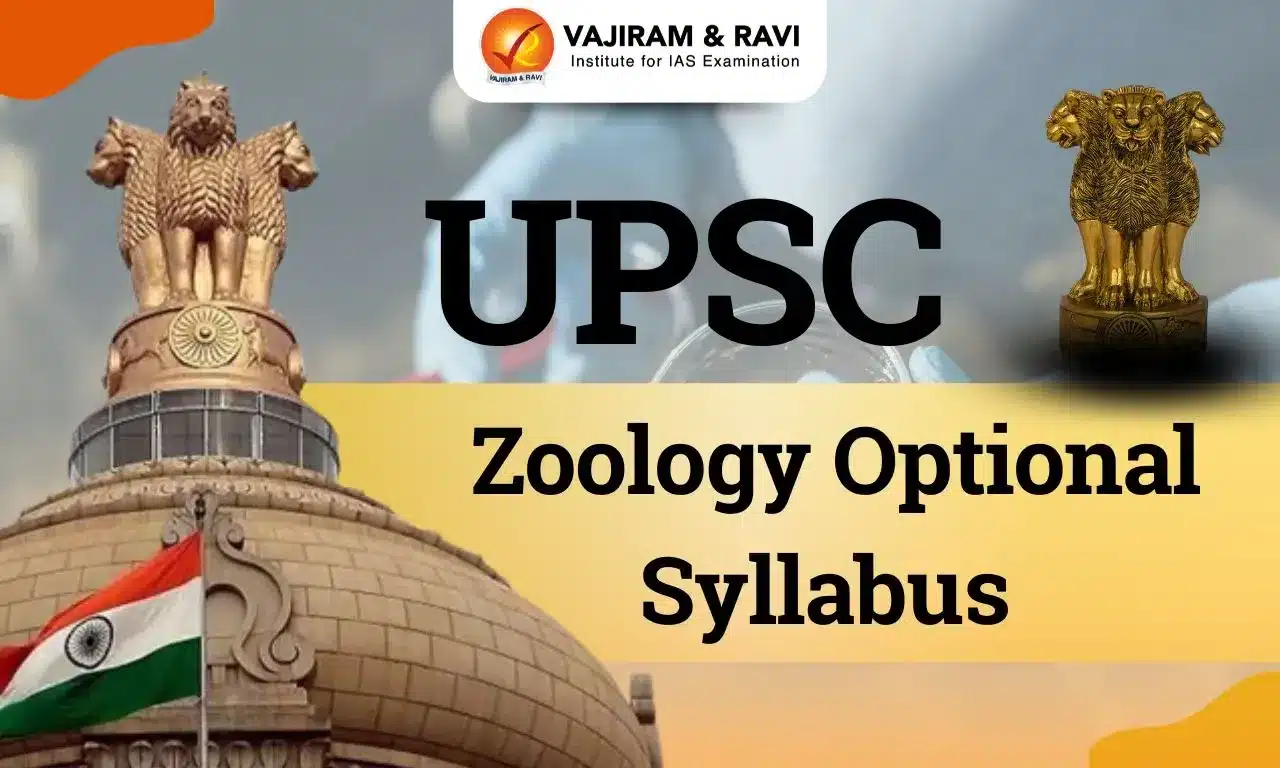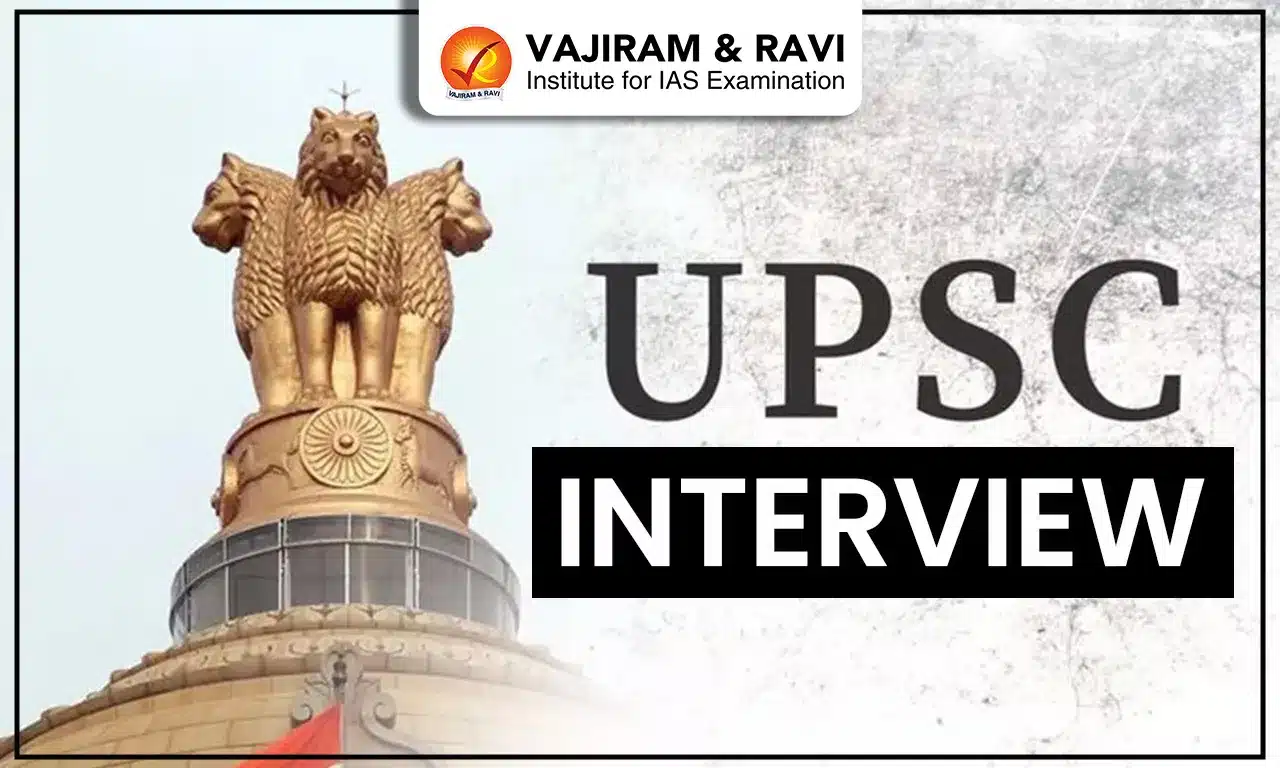UPSC Zoology syllabus: Zoology is one of the basic natural science subjects and is one of the popular optional subjects, especially amongst students with life science and medical backgrounds. The UPSC Zoology syllabus is reasonably large but can be mastered with a limited and smart approach. Although anyone can opt for this subject as an optional, due to its technical nature, only life science and medical graduates should be encouraged to go for this one.
Zoology includes the scientific study of every aspect of animals, such as anatomy, physiology, behaviour, biochemistry, genetics and biotechnology, ecology and evolution. It is a high-scoring subject and is also eligible for IFoS aspirants.
What is the UPSC Zoology Syllabus?
Zoology is one of the popular optional subjects opted for by UPSC aspirants with a life science background. As with other optional subjects, it carries 500 marks with two papers of 250 marks each. Following are the features of the Zoology as an optional subject:
- It is a technical subject; therefore, students having a non-life science background should not opt for this in the Main examination.
- The UPSC Zoology syllabus is vast and needs a comprehensive, in-depth study.
- As it is a strictly science subject, it has almost zero overlap with minimal overlap with the General Studies papers in the Main examination. However, it would be useful in prelims, provided the increasing level of the science section of the UPSC Prelims examination.
- The vastness and technicality of the subject demand at least 4-5 months of preparation with regular note-making and frequent revision.
- Once you have covered the UPSC Zoology syllabus, it would be a cakewalk in the optional paper because the questions asked in the Zoology optional are straightforward, thus making it a high-scoring subject.
UPSC Zoology Syllabus for Paper 1
Here is an overview of the Zoology optional syllabus for UPSC Paper-1:
Non-chordata and Chordata:
- Classification and relationship of various phyla up to subclasses: Acoelomate and Coelomate, Protostomes and Deuterostomes, Bilateria and Radiata; Status of Protista, Parazoa, Onychophora and Hemichordata; Symmetry.
- Protozoa: Locomotion, nutrition, reproduction, sex; General features and life history of Paramaecium, Monocystis, Plasmodium and Leishmania.
- Porifera: Skeleton, canal system and reproduction.
- Cnidaria: Polymorphism, defensive structures and their mechanism; coral reefs and their formation; metagenesis; general features and life history of Obelia and Aurelia.
- Platyhelminthes: Parasitic adaptation; general features and life history of Fasciola and Taenia and their pathogenic symptoms.
- Nemathelminthes: General features, life history, parasitic adaptation of Ascaris and Wuchereria.
- Annelida: Coelom and metamerism; modes of life in polychaetes; general features and life history of Nereis, earthworm and leech.
- Arthropoda: Larval forms and parasitism in Crustacea; vision and respiration in arthropods (Prawn, cockroach and scorpion); modification of mouth parts in insects (cockroach, mosquito, housefly, honey bee and butterfly); metamorphosis in insect and its hormonal regulation, social behaviour of Apis and termites.
- Mollusca: Feeding, respiration, locomotion, general features and life history of Lamellidens, Pila and Sepia, torsion and detorsion in gastropods.
- Echinodermata: Feeding, respiration, locomotion, larval forms, general features and life history of Asterias.
- Protochordata: Origin of chordates; general features and life history of Branchiostoma and Herdmania.
- Pisces: Respiration, locomotion and migration.
- Amphibia: Origin of tetrapods, parental care, paedomorphosis.
- Reptilia; Origin of reptiles, skull types, status of Sphenodon and crocodiles.
- Aves: Origin of birds, flight adaptation, migration.
- Mammalia: Origin of mammals, dentition, general features of egg laying mammals, pouched-mammals, aquatic mammals and primates, endocrine glands (pituitary, thyroid, parathyroid, adrenal, pancreas, gonads) and their interrelationships.
- Comparative functional anatomy of various systems of vertebrates (integument and its derivatives, endoskeleton, locomotory organs, digestive system, respiratory system, circulatory system including heart and aortic arches, urino-genital system, brain and sense organs (eye and ear).
Ecology:
- Biosphere: Concept of biosphere; biomes, Biogeochemical cycles, Human induced changes in atmosphere including greenhouse effect, ecological succession, biomes and ecotones, community ecology
- Concept of ecosystem; structure and function of ecosystem, types of ecosystem, ecological succession, ecological adaptation
- Population; characteristics, population dynamics, population stabilization
- Biodiversity and diversity conservation of natural resources
- Wildlife of India
- Remote sensing for sustainable development
- Environmental biodegradation, pollution and its impact on biosphere and its prevention
Ethology
- Behaviour: Sensory filtering, responsiveness, sign stimuli, learning and memory, instinct,habituation, conditioning, imprinting
- Role of hormones in drive; role of pheromones in alarm spreading; crypsis, predator detection,predator tactics, social hierarchies in primates, social organization in insects
- Orientation, navigation, homing, biological rhythms, biological clock, tidal, seasonal and circadian rhythms
- Methods of studying animal behaviour including sexual conflict, selfishness, kinship and altruism
Economic Zoology
- Apiculture, sericulture, lac culture, carp culture, pearl culture, prawn culture, vermiculture
- Major infectious and communicable diseases (malaria, filaria, tuberculosis, cholera and AIDS) their vectors, pathogens and prevention
- Cattle and livestock diseases, their pathogen (helminthes) and vectors (ticks, mites, Tabanus,Stomoxys)
- Pests of sugarcane (Pyrilla perpusilla) oil seed (Achaea janata) and rice (Sitophilus oryzae)
- Transgenic animals
- Medical biotechnology, human genetic disease and genetic counseling, gene therapy
- Forensic biotechnology
Biostatistics
- Designing of experiments; null hypothesis; correlation, regression, distribution and measure of central tendency, chi-square, student-test, F-test (one-way & two-way F-test)
Instrumentation Methods
- Spectrophotometer, phase contrast and fluorescence microscopy, radioactive tracer, ultracentrifuge, gel electrophoresis, PCR, ELISA, FISH and chromosome painting.
- Electron microscopy (TEM, SEM)
Zoology Optional Syllabus - Paper 2
Here is an overview of the Zoology optional syllabus for UPSC Paper-2:
Cell Biology
- Structure and function of cell and its organelles (nucleus, plasma membrane, mitochondria, Golgi Bodies, endoplasmic reticulum, ribosomes, and lysosomes), cell division (mitosis and meiosis), mitotic spindle and mitotic apparatus, chromosome movements, chromosome type polytene and lampbrush,organization of chromatin, heterochromatin, Cell cycle regulation
- Nucleic acid topology, DNA motif, DNA replication, transcription, RNA processing, translation, protein foldings and transport
Genetics
- Modern concept of gene, split gene, genetic regulation, genetic code
- Sex chromosomes and their evolution, sex determination in Drosophila and man
- Mendel’s laws of inheritance, recombination, linkage, multiple alleles, genetics of blood groups,pedigree analysis, hereditary diseases in man
- Mutations and mutagenesis
- Recombinant DNA technology; plasmid, cosmid, artificial chromosomes as vectors, transgenic,DNA cloning and whole animal cloning (principles and methods)
- Gene regulation and expression in prokaryotes and eukaryotes
- Signal molecules, cell death, defects in signaling pathway and consequences
- RFLP, RAPD and AFLP and application of RFLP in DNA fingerprinting, ribozyme technologies,human genome project, genomics and proteomics
Evolution
- Theories of origin of life
- Theories of evolution; Natural selection, role of mutations in evolution, evolutionary patterns,molecular drive, mimicry, variation, isolation and speciation
- Evolution of horse, elephant and man using fossil data
- Hardy-Weinberg Law
- Continental drift and distribution of animals
Systematics
- Zoological nomenclature, international code, cladistics, molecular taxonomy and biodiversity
Biochemistry
- Structure and role of carbohydrates, fats, fatty acids and cholesterol, proteins and amino-acids,nucleic acids. Bioenergetics
- Glycolysis and Kreb cycle, oxidation and reduction, oxidative phosphorylation, energy conservation and release, ATP cycle, cyclic AMP – its structure and role
- Hormone classification (steroid and peptide hormones), biosynthesis and functions
- Enzymes: types and mechanisms of action
- Vitamins and coenzymes
- Immunoglobulin and immunity
Physiology (with special reference to mammals)
- Composition and constituents of blood; blood groups and Rh factor in man, factors and mechanism of coagulation, iron metabolism, acid-base balance, thermo-regulation, anticoagulants
- Haemoglobin: Composition, types and role in transport of oxygen and carbon dioxide
- Digestion and absorption: Role of salivary glands, liver, pancreas and intestinal glands
- Excretion: nephron and regulation of urine formation; osmo-regulation and excretory product
- Muscles: Types, mechanism of contraction of skeletal muscles, effects of exercise on muscles
- Neuron: nerve impulse its conduction and synaptic transmission, neurotransmitters
- Vision, hearing and olfaction in man
- Physiology of reproduction, puberty and menopause in human
Developmental Biology
- Gametogenesis; spermatogenesis, composition of semen, in vitro and in vivo capacitation of mammalian sperm, Oogenesis, totipotency; fertilization, morphogenesis and morphogen, blastogenesis,establishment of body axes formation, fate map, gastrulation in frog and chick; genes in development inchick, homeotic genes, development of eye and heart, placenta in mammals
- Cell lineage, cell-to cell interaction, Genetic and induced teratogenesis, role of thyroxine in control of metamorphosis in amphibia, paedogenesis and neoteny, cell death, aging
- Developmental genes in man, in vitro fertilization and embryo transfer, cloning
- Stem cells: Sources, types and their use in human welfare
- Biogenetic law
UPSC Zoology Optional Syllabus PDF
UPSC aspirants should keep a copy of the Zoology syllabus handy during preparation to ensure all topics are covered. The PDF below outlines the syllabus in detail, including sub-topics, to help candidates plan their study effectively. Use it as a checklist to organise and focus your preparation.
Download: UPSC Zoology Syllabus PDF
How to Prepare UPSC Zoology Syllabus?
Looking at the vastness of the UPSC Zoology syllabus, it is natural to have anxiety regarding the perfect strategy to cover and revise the entire syllabus of zoology. Here are some tips, notwithstanding every aspirant's own strengths and weaknesses regarding the topics of the subject:
- Start with an overview of the syllabus and previous years' question papers to identify important topics and the exam pattern. As the questions would be static, there is less scope for the manoeuvring.
- There needs to be a smart approach to cover all the topics of the Zoology Optional syllabus and their aspects. Make chapter-wise notes, it's very useful.
- The aspirants must have expertise in diagram drawing as there would be few questions demanding for the same. Likewise, you should be fully aware of flowcharts regarding biochemical pathways and biogeochemical cycles.
- The basic understanding of the subject should be done from the NCERT Biology books (both XI and XII). Also, books regarding the NEET preparation can be helpful in understanding the syllabus and pattern of the Paper.
- The focus should be more on the basic concepts as Questions No. 1 and 5 of both the papers more or less cover the conceptual parts.
- Refer to standard textbooks prescribed in the last section of this article. There is no need to study the entire book. Refer to specific chapters and topics based on the UPSC Zoology syllabus and the pattern of the questions. Further, there are some topics for which NCERT is enough.
- Topics which are relatively easy, such as Economic zoology, ecology, evolution, biostatistics, and instrumentations, etc., should be focused more. These would help in scoring high marks.
Important Topics in UPSC Zoology Syllabus
Although UPSC asks questions from every section of the Zoology syllabus, here is a list of important topics that should be focused on more than others:
Chordata and Non-chordata
- Classification and relationship of various phyla up to subclasses
- Mammalia
- Comparative functional anatomy of various systems of vertebrates
Physiology
- Transport of oxygen and carbon dioxide
- Digestion and absorption
- Physiology of reproduction
- Neuron
Biochemistry
- Enzymes: types and mechanisms
- Immunoglobulin and immunity
Cell Biology
- Cell division and cell cycle
Genetics
- Mendel’s laws of inheritance
- Recombinant DNA technology
Ecology
- Biogeochemical cycles
- Structure and function of ecosystem
- Biodiversity and diversity conservation of natural resources
- Pollution and its prevention
Evolution
- Theories of evolution; Natural selection, role of mutations in evolution
- Hardy-Weinberg Law
Developmental Biology
- Gametogenesis;
- Developmental genes in man
- Stem cells
Economic Zoology
- Different types of culture
- Diseases and Medical biotechnology
Transgenic animals
Biostatistics
- Distribution and measure of central tendency
- Null hypothesis
- Chi-square test
Instrumentation Methods
- Different types of microscopy
Booklist for Zoology Optional for UPSC
The most important books for the preparation of UPSC Zoology syllabus are NCERT Biology XI and XII (non-rationalised version). First, go through the General Biology section and Zoology-related chapters. Once done, go through the following textbooks. It is not necessary to read each book comprehensively and focus on the specific chapters and topics relevant to the syllabus and previous years' questions. As Zoology is a strictly static optional, there is no need to follow current affairs for this.
Books for Zoology Paper 1
| Subject | Book Title | Authors |
| Invertebrate Zoology | Invertebrate Zoology | P S Verma and E L Jordan |
| Chordate Zoology | Chordate Zoology | P S Verma and E L Jordan |
| Comparative Anatomy of Vertebrates | Vertebrates Comparative Anatomy, Function, Evolution by K. Kardong | K. Kardong |
| Ecology | Ecology and Environment by Dr. P.D. Sharma | Dr. P.D. Sharma |
| Ethology | Animal Behaviour (Ethology) by Agarwal V.K. | Agarwal V.K. |
| Economic Zoology | Applied And Economic Zoology by Dr. V. B. Upadhyay and Dr. G. S. Shukla | Dr. V. B. Upadhyay and Dr. G. S. Shukla |
| Bioinstrumentation | Bioinstrumentation by Bhawana Pandey and M.H. Fulekar | Bhawana Pandey and M.H. Fulekar |
| Biostatistics | Fundamentals of Biostatistics by Veer Bala Rastogi | Veer Bala Rastogi |
Books for Zoology Paper 2
| Subject | Book Title | Authors |
| Cell Biology |
Karp's Cell Biology Molecular Cell Biology |
Karp Gerald David Baltimore and Harvey Lodish |
| Genetics | Concepts of Genetics | Klug and Cummings |
| Evolutionary Biology | Organic Evolution | Veer Bala Rastogi |
| Biochemistry |
Biochemistry Lehninger Principles of Biochemistry (selected chapters) |
U. Satyanarayana David L. Nelson, Michael M. Cox |
| Animal Physiology (with special reference to mammals) | Tortora's Principles of Anatomy and Physiology | Bryan H. Derrickson, Gerard J. Tortora |
| Developmental Biology | Developmental Biology | Scott F. Gilbert |
| Other Related UPSC Optional Syllabus | ||
|---|---|---|
|
UPSC Animal Husbandry & Veterinary Science Optional Syllabus |
|
|
Last updated on December, 2025
→ Check out the latest UPSC Syllabus 2026 here.
→ Join Vajiram & Ravi’s Interview Guidance Programme for expert help to crack your final UPSC stage.
→ UPSC Mains Result 2025 is now out.
→ UPSC Notification 2026 is scheduled to be released on January 14, 2026.
→ UPSC Calendar 2026 is released on 15th May, 2025.
→ The UPSC Vacancy 2025 were released 1129, out of which 979 were for UPSC CSE and remaining 150 are for UPSC IFoS.
→ UPSC Prelims 2026 will be conducted on 24th May, 2026 & UPSC Mains 2026 will be conducted on 21st August 2026.
→ The UPSC Selection Process is of 3 stages-Prelims, Mains and Interview.
→ UPSC Result 2024 is released with latest UPSC Marksheet 2024. Check Now!
→ UPSC Prelims Result 2025 is out now for the CSE held on 25 May 2025.
→ UPSC Toppers List 2024 is released now. Shakti Dubey is UPSC AIR 1 2024 Topper.
→ UPSC Prelims Question Paper 2025 and Unofficial Prelims Answer Key 2025 are available now.
→ UPSC Mains Question Paper 2025 is out for Essay, GS 1, 2, 3 & GS 4.
→ UPSC Mains Indian Language Question Paper 2025 is now out.
→ UPSC Mains Optional Question Paper 2025 is now out.
→ Also check Best IAS Coaching in Delhi
Zoology Optional Syllabus FAQs
Q1. Will there be UPSC exam in 2026?+
Q2. Will optional be removed from UPSC 2026?+
Q3. Is zoology a good optional for UPSC?+
Q4. How to plan for UPSC 2026?+
Q5. What is the syllabus of UPSC 2026?+

















